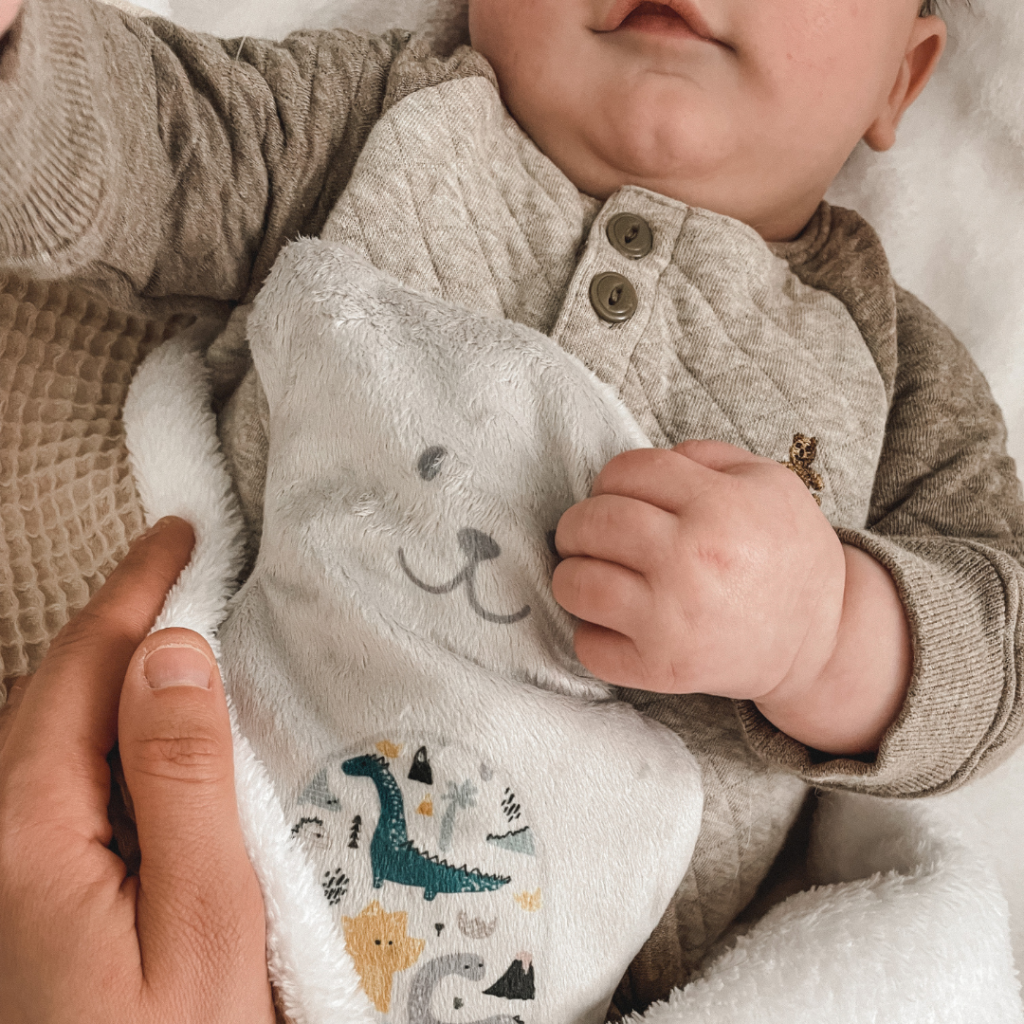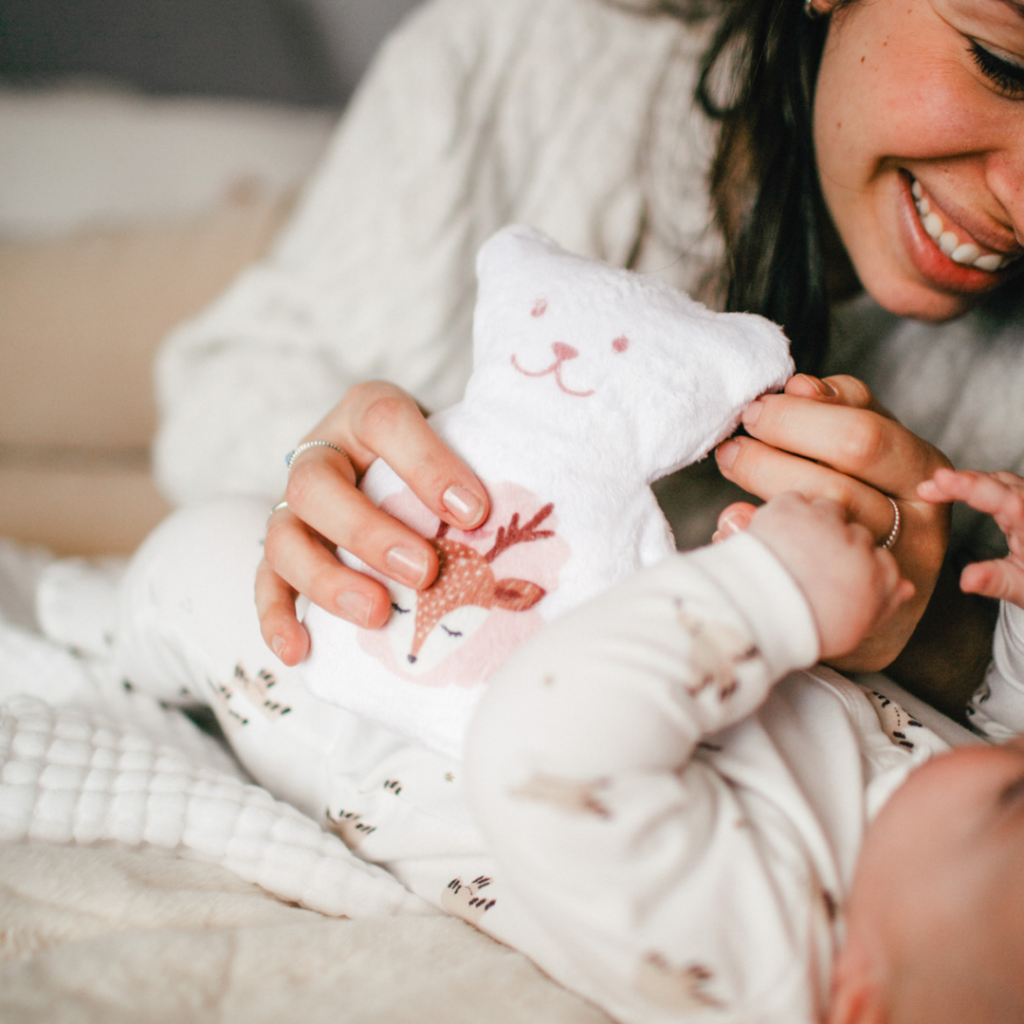To increase baby’s sense of security and ease their anxiety, it is important to set up a bedtime ritual that will allow your little one to recognize the stages of the day and associate the actions you put in place to bedtime. Here’s a quick look at a routine that really works and that can be adapted over time!
What is a bedtime ritual?
A bedtime ritual is a series of small, simple actions that, when performed daily at bedtime, will help your child recognize the time of day and anticipate what’s coming next. Whether it is short or long, simple or complex, the bedtime ritual reassures your child through repetition. But rest assured, length and complexity do not make the sleeping ritual more effective… All it takes is a few gestures—and about fifteen minutes … and that’s it!
At what age can you start a ritual?
The first three months of a baby’s life require a great deal of adaptability within the family, as everyone finds their balance. However, from the age of 3 months, you can start to establish a bedtime ritual. Of course, this routine will evolve over the months and years, but it will already help to reassure your child at bedtime.

An evolving ritual
Here are a few examples of sleeping rituals depending on your child’s age:
The ritual for newborns
- Bath time. A quiet bath will help your baby relax before bedtime.
- Pyjamas. Put on pyjamas that are suitable for the temperature of the room—be careful not to overdress your baby so that he or she doesn’t wake up sweating in the middle of the night!
- Darkness. Dim the lights and retreat to your baby’s quarters so that the environment is familiar.
- Feeding him. Breastfeed or give baby his bottle in a dark, quiet place.
- Swaddling. If your child likes to be swaddled, you can wrap him tightly before rocking him gently to a song.
- Singing. Gently sing a song to your baby—ideally the same one every night. While singing the song, you can gently rock your baby (standing or in a rocking chair), stroke his forehead (from the top of his forehead to the bridge of his nose) or rub his back gently clockwise. You can also cuddle your baby with his ear pressed against your heart—your heartbeat will remind him of mummy’s tummy and soothe him. And if you don’t like singing, you can also play a music box.
- Kissing. Give your baby a little kiss on the forehead and try to put him to bed when he is still awake. By doing this, you are teaching him to fall asleep on his own and you are sending him a simple but very important message: he does not have to fear solitude!
The ritual for toddlers (1 to 4 years)
- A notice. When your child is starting to assert his character, experiment with “no” or negotiate fiercely, a notice before bedtime can work wonders! Give your child one or two warnings (e.g., at 10 and 5 minutes before the start of your ritual), to prevent a crisis :).
- Bath time. With older children, bath time can quickly become a time of play and fun—but if possible, try to keep a calm atmosphere to get them in the mood for bed.
- Brushing teeth. Once your child has had his bath, you can make brushing his teeth part of the ritual! Start by brushing his teeth well, then if he wants, let him brush a little too. You can even sing a little song while brushing to make sure you’ve brushed forwards, backwards … and long enough!
- Pyjamas. Your child can gradually start to put on the trousers on their own—and then even the top!
- The story. A short story like Curious George books or Peppa Pigs are great—they’re repetitive… And there’s a whole range of them to vary a bit (although you’ll probably read the same story over 200 times, let’s face it!)
- The sip of water and the loo. That’s right—by being proactive, you limit your child’s reasons for getting up after you’ve said “good night”!
- Monster hunting. If your child is a bit skittish, you can take a few seconds to chase monsters with him before dimming the lights! Look under the bed and in the wardrobe by saying a magic spell or by spraying monster repellent that you make in a spray bottle filled with water and a few drops of lavender essential oil. The smell of lavender will soon be associated with the bedtime ritual!
- Darkness. Dim the lights well before the kiss.
- The kiss. A kiss, and good night… You can even add a wish, like “see you in dreamland,” or “sleep well”!
The ritual for older children (5 years and over)
- Bath time. By now your child should be able to wash himself, perhaps with the exception of his hair. Keep an eye on them and wash them again if necessary!
- Brushing teeth. As for teeth, your child can now brush on their own—although it may be a good idea to brush after them to make sure you rub the back teeth well!
- Pajamas. Your child can go and put on their pyjamas on their own and wait for you in bed.
- Readingtime. Depending on your preference, reading time can become a time when your child “reads” alone in bed before you come to bed. Learning to relax alone can be beneficial. You can also read a few pages of a novel, a book of tales or other stories. At this age, it can be interesting to read a longer book in several parts, so that your child can anticipate what will happen next and remember what happened the day before!
- Darkness and kissing. Keeping the routine short and simple will always help your child learn to fall asleep on his own. And, if fears or anxieties arise as they grow up, remaining firm and reassuring without giving in will help build their confidence!

The key to success
Calmness
It is very important to create a calm atmosphere before and during the bedtime ritual! If your child is very agitated before going to bed, you may find it very difficult to spend a relaxing and soothing moment with him. So, before starting the routine, offer calm activities and avoid teasing, making them laugh or overexciting them.
Warmth
It is important to maintain a comfortable temperature in your child’s room—not too hot and not too cold (around 20 degrees). Without being overdressed, your child will fall asleep more easily with a source of warmth that comforts him or her.
A hot-water bottle, such as the Béké-Bobo therapeutic teddy bear, will help your child to relax and fall asleep. If your child suffers from colic, the moist heat will also magically relieve his abdominal pain, allowing his little body to relax completely. And what’s more, the teddy bear can be used as a bedtime companion, because it’s adorable!
Consistency
Don’t skip nights—even when you’re tired! And always perform the little ritual in your child’s environment (put him to sleep in his bed, read the story in his room, etc.). Also try to do this little ritual at approximately the same time every night, as this will help to build up a sense of security in your child.
Flexibility
Adapt the ritual (each in their own way: mum, dad, the nanny or grandma and grandpa). Moreover, if you have the possibility, try to vary the person who puts baby to bed regularly, this will avoid a crisis when you have to (or want to!) go away. Even if it doesn’t go as well. Yes, yes—even if you do it better than anyone else :).
Perseverance
Don’t give up, even when you feel that “it’s not working.” This doesn’t mean that you have to repeat actions that don’t work—you can adjust the bedtime ritual anytime, but if possible, don’t give up by taking your baby to sleep or going for a drive!
Patience
Does your baby start crying again as soon as you drop him off or leave the room? Take several deep breaths and wait a few minutes to see if your child goes back to sleep on his own. You’ll be surprised to see that most babies find a way to comfort themselves!

Incredible, but true.
A less tired baby will fall asleep more easily than an exhausted baby!
Skipping a nap will not make your child sleep better at night… Children need a nap until they are about 3 years old! Extreme tiredness will make your child even more irritable and it will be even more difficult to get them to sleep. We promise you: structuring your child’s day well will help them sleep better. So don’t deprive him of a nap!
Un bébé qui gazouille apprend l’autonomie
Letting your baby sing, talk or even cry a little won’t do him any harm. It’s even a way for him to get used to his alone time and to enjoy waiting for sleep to come! Encourage him to develop his autonomy from the very first months… The whole family will benefit!
What is your magic ritual? Share your successes with the Béké-Bobo family on Facebook and Instagram!
